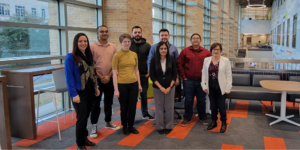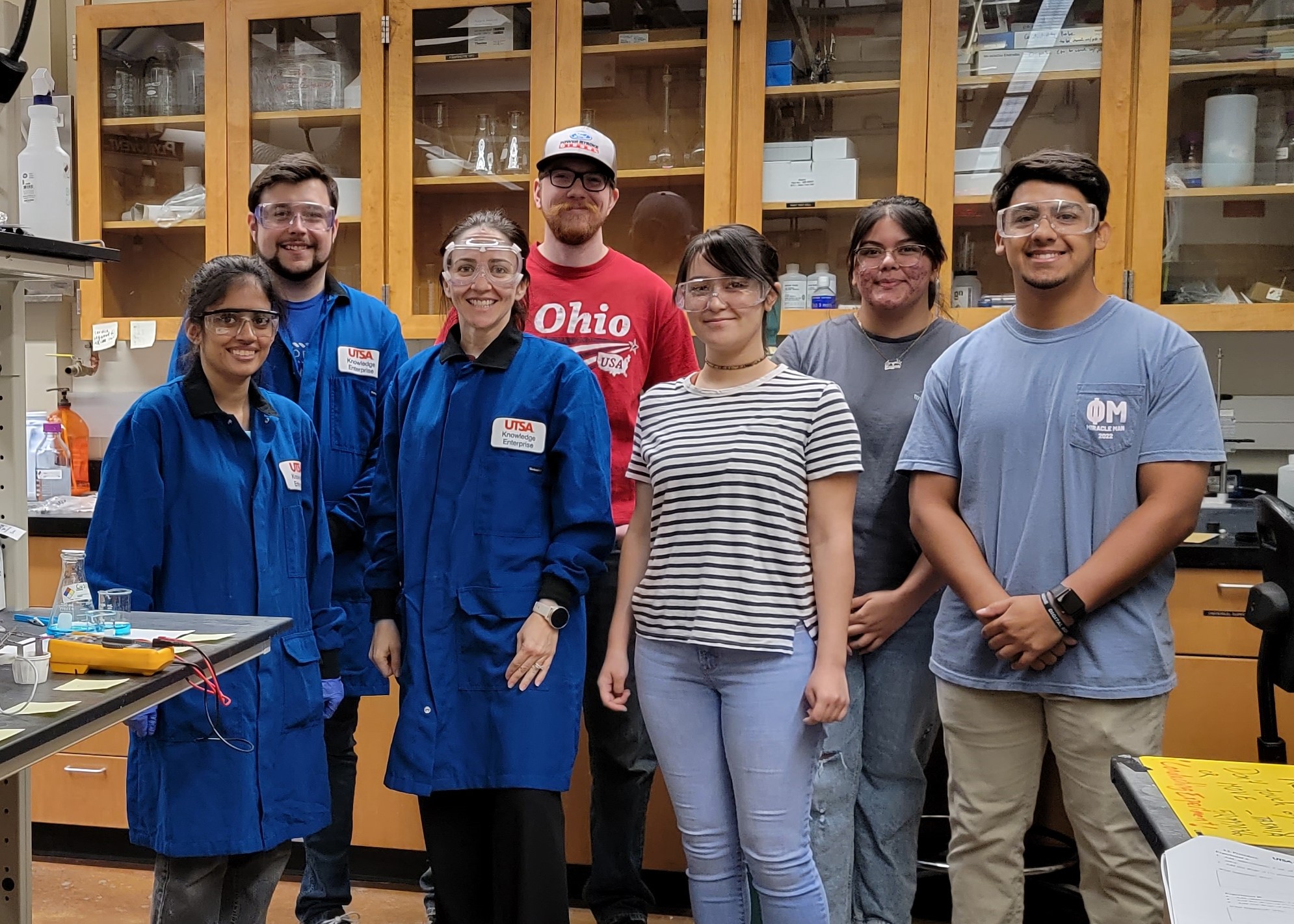APRIL 27, 2022 – The UTSA Corrosion Research Laboratory founded in 2016 by Brendy Rincon Troconis , assistant professor of mechanical engineering, integrates experimental approaches with accelerated degradation through harsh environments (salts, temperature, humidity) and extensive materials characterization with computational modelling to better understand corrosion and assist industrial partners in mitigating its effects. Throughout 2021, Rincon Troconis and her team of student researchers, collaborators, and visiting scientists secured research funding from five governmental and industry partners.
Addressing corrosion challenges head on
The UTSA Corrosion Laboratory, in collaboration with David Restrepo (co-principal investigator and assistant professor in the Department of Mechanical Engineering), is supporting the US Office of Naval Research by investigating the effect of stress on corrosion kinetics. “A report from aircrafts teardowns showed that nearly 80% of cracks on military aircrafts have been found in close proximity to corrosion sites,” said Rincon Troconis. “Considering that aircrafts are also exposed to mechanical stress, it’s important to best understand how they affect corrosion. This can be done through the evaluation of corrosion and attack on structural alloys in relevant conditions. All this information can feed structural life management tools and lead to more efficient maintenance schedules.”
The UTSA Corrosion Laboratory is also supporting BASF | Chemetall to explore surface treatments used in autobody paneling and their interaction with epoxy adhesives used in the production of vehicles. In this project, an improved coating adhesion testing protocol is being developed to quantitatively measure adhesion strength under relevant conditions.
Improving the safety and durability of construction materials
Visiting Professor Oladis Troconis de Rincon (an expert in corrosion in reinforced concrete) and the Corrosion Laboratory have also partnered with Texas-based Twin Hawk LLC to refine a commercial grade coating that minimizes corrosion and improves the durability of the reinforced concrete over time. “We have previously demonstrated the efficiency of Twin Hawk’s product and are now bringing the chemical production onto campus to optimize the surface preparation and coating process parameters, and expand the testing to include accelerated corrosion chambers and field testing related to reinforced concrete applications” said Rincon Troconis. Additionally, as part of the Transport Consortium of South-Central States (Tran-SET), the same research team is collaborating with Universidad de Costa Rica and Texas A&M University to test an environmentally sustainable corrosion inhibitor to increase the durability of reinforced concrete in a sustainable way, while minimizing risks to humans and the broader environment.
Looking after the next generation of scientists
The Department of Energy’s National Nuclear Security Administration (DOE/NNSA) has awarded $4 million to the Consortium for Advanced Manufacturing to develop and sustain Consortium of Advanced Additive Manufacturing Research and Education for Energy Related Systems (CA2REERs) to expose, recruit, engage and train students from underrepresented groups for career advancement in manufacturing for energy. In association with Frank Chen (Lutcher Brown Distinguished Chair in Advanced Manufacturing and professor in the Department of Mechanical Engineering), Rincon Troconis is spearheading the UTSA collaborative research projects with UTSA’s partners: UT Rio Grande Valley, University of Arizona, Los Alamos National Laboratory and Oak Ridge National Laboratory. The NNSA grant will support institutional capability in developing research in advanced material, advanced manufacturing, and renewable energy. Rincon Troconis’ research will focus on atmospheric corrosion and hydrogen embrittlement of additively manufactured alloys.
The CA2REERs consortium will also promote an exchange program with these institutions to allow undergraduate and graduate students to learn from each other and to participate in summer workshops and camps for high school students to increase the visibility to the STEM field.
Throughout all these projects, Rincon Troconis focuses on research opportunities for students. “While I serve as the advisor of the lab, the students facilitate much of the research themselves and are the key to its success,” said Rincon Troconis.

From left to right: Brendy Rincon Troconis, Drishya Dahal, Meggan Wolanin, Luis Perdomo-Hurtado, Nayab Ali, Jorge Escribano, Loreto Jonathan Dacio, and Oladis Troconis de Rincon
A vision for the future
Rincon Troconis, has big aspirations for the future of the UTSA Corrosion Lab. As she progresses along her tenure-track path, she hopes to continue the momentum and bring additional recognition to UTSA as a center of academic inquiry related to corrosion and supporting safety in several industries. “Corrosion is a significant risk to safety in many fields. Therefore, I hope our ongoing work generating knew knowledge and techniques will positively impact safety across the board,” said Rincon Troconis.
She also aims to be a resource for current and future students. “I am proud to be pursuing the work that I do and also be raising three happy and healthy children,” said Rincon Troconis. “It is definitely possible to pursue your professional and personal dreams. While UTSA has facilitated work on corrosion in the past, my lab is the first on campus to focus on it specifically.”
Dr. Rincon Troconis was recently recognized as one of six recipients of the 2021 Gulf Research Program Early-Career Research Fellow in the Offshore Energy Safety Track from the National Academies of Science, Engineering, and Medicine.


